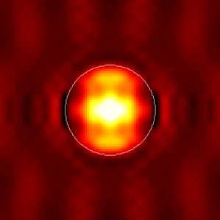The theory of diffraction according to Fresnel or Kirchoff is a scalar wave theory which is not sufficient to describe various optical effects. This is so because physical boundary conditions have to be neglected with a scalar approach. Real electromagnetic corrugations are vectorial waves. As structure sizes decreases particularly in semiconductor technology, patterns with dimensions comparable to the wavelenght of visible light become focus of research. There, interaction effects of light and structure strongly influence diffraction spectra of reflected and trasmitted light. These contributions can be merely considered by rigorous calculations applying full vectorial Maxwell equations. In contrast to scalar optics there are only few analytical solutions for rigorous diffraction so numerical methods are used inpractice. ITO has been active in the field of rigorous numerical simulation of diffraction on periodic structures since end of 1990. Since then, our simulation tool Microsim, which is powered by a rigorous coupled wave approximation (RCWA), has been continuously used and improved.
You can find more details about Microsim in our software section.
Publications
- M. Totzeck, "Numerical simulation of high-NA quantitative polarization microscopy and corresponding near-fields", Optik, 112 (2001) 381-390
- Reinig P., Dost R., Mört M., Hingst, T., Mantz U., Schuster, T. Kerwien, N., Kaufmann J., Osten W.: "Potential and limits of scatterometry: A study on bowed profiles and high aspect ratios", Scatterometry Workshop 2004, 3.-5.5.2004 Porquerolles, Frankreich
- R. Berger, J. Kauffmann, N. Kerwien, W. Osten, H.J. Tiziani: Rigorose Beugungssimulation: Ein Vergleich zwischen RCWA, DTD und der Finiten Elemente Methode, 105. DgaO-Tagung 2004 P59
- Kerwien N., Schuster T., Rafler S., Osten W., "Semi-rigorous Diffraction Theory: Realization of Classical Concepts in the Framework of Electrodynamics", J. Opt. Soc. Am. A 24 (2007) No. 4 1074-1084


